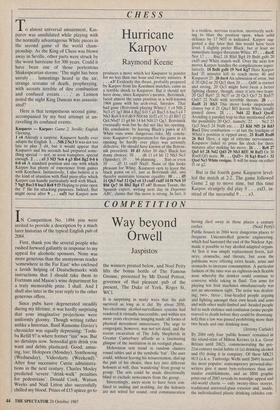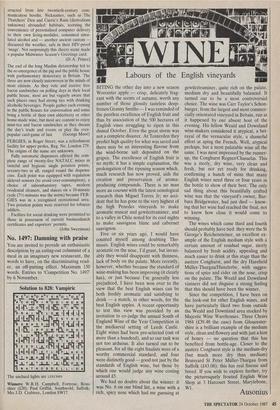COMPETITION
Way beyond Orwell
Jaspistos
IN Competition No. 1494 you were invited to provide a description by a much later historian of the typical English pub of 2084.
First, thank you the several people who rushed forward gallantly in response to my appeal for alcoholic sponsors. None was more generous than the anonymous reader 'somewhere in the Far East' who enclosed a lavish helping of Deutschemarks with instructions that I should take them to Fortnum and Mason's wine department for a truly memorable prize. I shall. And I shall also later in the year reply to the other generous offers.
Since pubs have degenerated steadily during my lifetime, it was hardly surprising that your imaginative projections were uniformly gloomy. Though writing rather unlike a historian, Basil Ransome-Davies's chronicler was equally depressing: 'Toshi- ba Refill 97 is where former "inn" was. But no dirtslops now. Sensodial gets drink you want and debits plasticard. Good, amus- ing, too: Holoporn (Monday), Synthosong (Wednesday), Videodarts (Weekend).' After four successive Currie administra- tions in the next century, Charles Mosley predicted 'severe "drink-walk" penalties for pedestrians'. Donald Cook, Watson Weeks and Niall Litton also successfully chilled my blood. Prizes of fl5 apiece go to the winners printed below, and Noel Petty lifts the bonus bottle of The Famous Grouse, presented by Mr David Potton, governor of that pleasant pub of the present, The Duke of York, Roger St, WC1.
It is surprising in many ways that the pub survived as long as it did. By about 2050, bio-electronic alcohol-surveillance systems had rendered it virtually inaccessible, and within ten more years electronic imaging made all forms of physical movement unnecessary. The urge to congregate, however, was not yet dead, and the recent excavation of The Jolly Shepherds in Greater Canterbury affords us a fascinating glimpse of the institution in its vestigial phase.
Holovision sets stand in random clusters round tables and at the symbolic 'bar'. The user could, without leaving his leisurestation, dial-up the pub of his choice, then key into different holosets at will, thus 'wandering' from group to group. The sets could be made directionally blind to exclude newcomers from the group.
Interestingly, users seem to have been con- fined to smiling and nodding, for the holosets are not wired for sound, oral communication having died away in these places a century earlier. (Noel Petty) Public houses in 2084 were dangerous places to frequent. Uncontrolled genetic engineering, which had hastened the end of the Nuclear Age, made it possible to buy alcohol-adapted organs. At first it was simply replacement livers, kid- neys, stomachs, and throats, but soon the publicans were offering extra heads, arms and stomachs to increase consumption. A particular fashion of the time was an eighteen-inch flexible nose whereby the drinker could continue to converse while taking in fluid. Ten arms for playing ten fruit machines simultaneously was not an uncommon sight. The noise was deafen- ing; two-, three-, four-headed people arguing and fighting amongst their own heads and arms and with other multi-limbed and -headed people led to such violence and confusion (some people starved to death before they could be disentang- led) that a law was passed prohibiting more than two heads and one drinking nose.
(Jeremy Carlisle) By 2084 only four 'public houses' remained in the island-state of Milton Keynes (a.k.a. Great Britain until 2062), commemorating the pre- 21st-century social habits of (a) drinking alcohol and (b) doing it in company. Of these MK21 8UJ (a.k.a. Tunbridge Wells until 2049) housed the most popular: contemporary personal-disc- writers give it more byte-references than any similar establishment, and an IBM graphic print-out of 2083 reveals its nostalgic appeal and old-world charm — only twenty-three storeys, traditional mirrored-glass exterior and, inside, the individualised plastic drinking cubicles con- structed from late twentieth-century com- munication booths. Nicknames, such as The Thatchers' Den and Currie's Ruin (derivations unknown) abounded: habitués, scorning the convenience of personalised computer delivery to their own living-modules, consumed simu- lated alcohol and — another ancient custom discussed the weather, safe in their HIV-proof `snugs'. Not surprisingly this cheery scene made a popular Midwinter Season's Greetings card.
(D.A. Prince) The end of the long Muslim dictatorship led to the re-emergence of the pig and the public house with parliamentary democracy in Britain. The three are now closely interwoven in the minds of most citizens. As they vote and receive free bacon sandwiches on polling days in their local public house, most are but vaguely aware that such places once had strong ties with drinking alcoholic beverages. People gather each evening in the public 'houses for conversation and some bring a bottle of their own elderberry or other home-made wine, but most are content to enjoy mint-tea and bacon sandwiches as they discuss the day's trade and events or play the ever- popular card-game of lust. (George Moor) FERGIES, in Roger Street, was a refreshment facility for upper proles, Reg. No. London 279. The origins of the name are unknown.
Fully automatic dispensers offered the com- plete range of twenty-five NATALC mixes in tasteful and hygienic single potation points, seventy-two in all, ranged round the dispense core. Each point was equipped with regulation alclevel sensors (to avoid over-consumption), a choice of saloonbarstory tapes, modern orodental cleaners, and sluices on a 10-minute cycle (71/2-minutes was the norm) because FER- GIES was in a recognised recreational area. Two potation points were reserved for tobacco addicts.
Facilites for social drinking were permitted to those in possession of current businesslunch certificates and exporters' permits.
(John Sweetman)



















































 Previous page
Previous page